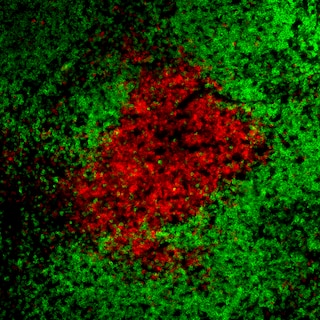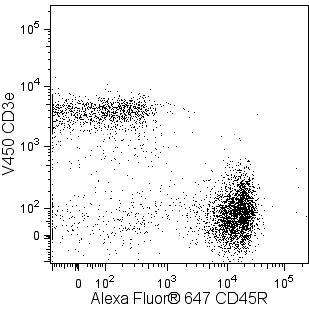Old Browser
Looks like you're visiting us from {countryName}.
Would you like to stay on the current country site or be switched to your country?


.png)

Multicolor flow cytometric analysis of Ly-108 expression on mouse bone marrow cells and thymocytes. Mouse bone marrow cells and thymocytes were stained with PE Mouse anti-Mouse Ly-108, Alexa Fluor® 647 Rat Anti-Mouse CD45R/B220 (Cat. No. 557683) and BD Horizon™ V450 Hamster Anti-Mouse CD3e (Cat. No. 560801) antibodies. Two-color flow cytometric dot plots show the correlated expression of CD45R (bone marrow cells, Left Panel) or CD3 (thymocytes, Right Panel) versus Ly-108 for gated events with the forward and side light-scatter characteristics of viable lymphocytes. Flow cytometry was performed using a BD™ LSR II Flow Cytometer System.
.png)

BD Pharmingen™ PE Mouse anti-Mouse Ly-108
.png)
Regulatory Status Legend
Any use of products other than the permitted use without the express written authorization of Becton, Dickinson and Company is strictly prohibited.
Preparation And Storage
Product Notices
- Since applications vary, each investigator should titrate the reagent to obtain optimal results.
- Caution: Sodium azide yields highly toxic hydrazoic acid under acidic conditions. Dilute azide compounds in running water before discarding to avoid accumulation of potentially explosive deposits in plumbing.
- For fluorochrome spectra and suitable instrument settings, please refer to our Multicolor Flow Cytometry web page at www.bdbiosciences.com/colors.
- Please refer to www.bdbiosciences.com/us/s/resources for technical protocols.
Companion Products



The 13G3 monoclonal antibody specifically binds to Lymphocyte antigen 108, Ly-108. Ly-108 is a member of the signaling lymphocytic activation molecule (SLAM) family of immune receptors. Ly-108 is a type 1 transmembrane glycoprotein adhesion receptor that is expressed by T cells, NKT cells, B cells, NK cells, macrophages, dendritic cells and neutrophils. Ly-108 plays multiple roles in innate and adaptive immunity including costimulation of NK cell cytotoxicity and T cell cytokine responses. Moreover, Ly-108 has been implicated in autoimmunity.

Development References (4)
-
Griewank K, C Borowski, Rietdijk S, et al. Homotypic interactions mediated by Slamf1 and Slamf6 receptors control NKT cell lineage development. Immunity. 2007; 27(5):751-762. (Clone-specific: Flow cytometry, Immunofluorescence). View Reference
-
Howie D, Laroux FS, Morra M, et al. Cutting edge: the SLAM family receptor Ly108 controls T cell and neutrophil functions. J Immunol. 2005; 10(174):5931-5935. (Biology). View Reference
-
Li W, Sofi MH, Rietdijk S, Wang N, et al. The SLAM-Associated Protein (SAP)/Fyn/PKCθ Pathway is Required for Thymocyte-mediated CD4 T Cell Development. Immunity. 2007; 27(2):763-774. (Biology). View Reference
-
Peck SR, Ruley HE. Ly108: a new member of the mouse CD2 family of cell surface proteins. J Immunol. 2000; 52(1-2):63-72. (Biology). View Reference
Please refer to Support Documents for Quality Certificates
Global - Refer to manufacturer's instructions for use and related User Manuals and Technical data sheets before using this products as described
Comparisons, where applicable, are made against older BD Technology, manual methods or are general performance claims. Comparisons are not made against non-BD technologies, unless otherwise noted.
For Research Use Only. Not for use in diagnostic or therapeutic procedures.
Report a Site Issue
This form is intended to help us improve our website experience. For other support, please visit our Contact Us page.